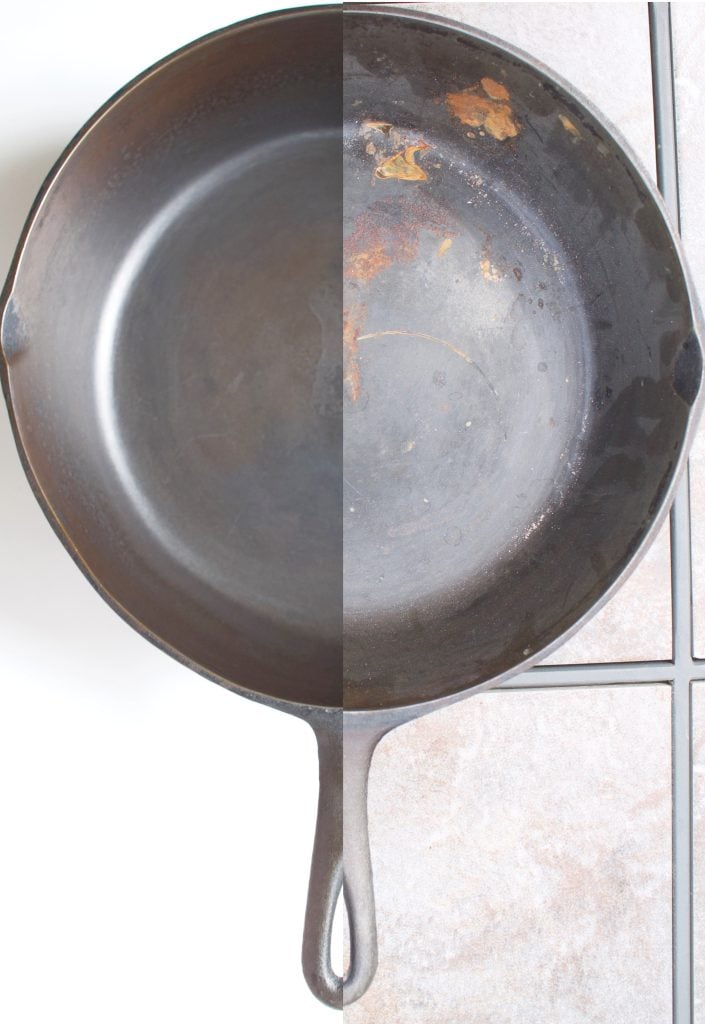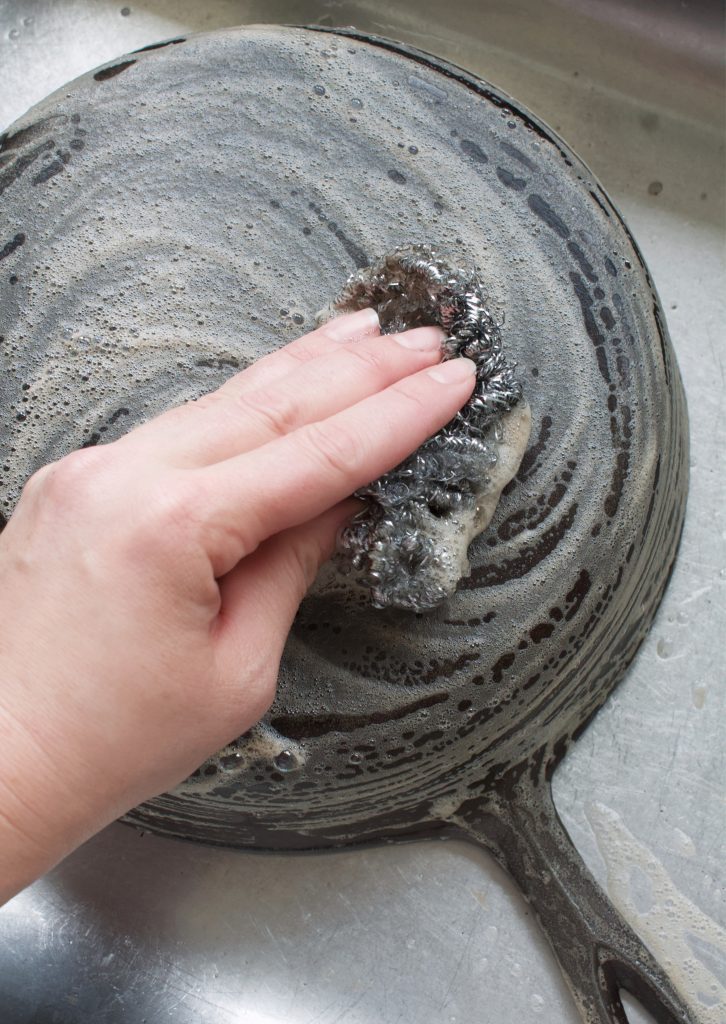How To Season and Restore A New or Rusty Cast Iron Skillet
I’ve had an unused cast-iron skillet in the bottom drawer of my kitchen for years. If I’m being transparent here, I’m not even sure how it got there. Why haven’t I used the sad, lonely cast-iron skillet?
I was scared, friends.
There was rust on it. Ick.

I’d been told you could season it, but that sounded like a lot of work—until today. For some reason, I decided to just go for it. Maybe it’s this whole quarantine thing, getting us to do things like feeding sourdough starter, making artisan bread, baking pies, and getting creative with homemade pizza, and on and on.
So, I decided to season a skillet today. If you don’t have a new cast iron pan, don’t fear, my friends. This one is a great price, and I’m told if you take proper care of them (and even if you don’t), they’ll last long enough to be passed down to your children, and your children’s children. So it’s apparently a worthwhile purchase.

One more reason I decided to give it a try: cast iron cookware, when seasoned correctly, is a chemical-free non-stick pan. I’m all about reducing chemicals in my home.
I’m here to tell you, I’ve successfully seasoned a cast iron skillet. It’s done! And friends, it wasn’t that bad. In fact, it was kind of satisfying. But then, I’m such a sucker for before and afters.
* A 2024 update:
Four years after originally penning this post, I’m still using this same, well-seasoned cast iron pan. It’s my go-to. I use it daily, several times a day. Because of the constant use, it’s buttery smooth and non-stick. Eggs flip perfect and it cooks evenly. If you’re on the fence about purchasing or seasoning one, let this be your sigh to do it! And if you get one that’s new, my best piece of advice is to take a fine grain sandpaper and sand the bottom of the cooking portion of the pan before seasoning to give it that non-stick, well used surface. Your eggs which will flip like a dream will thank you!
Seasoning a Cast-Iron Skillet
The good thing about seasoning cast iron cookware is you really only need to do it if your pan is new or if you’re restoring it. As long as you clean it properly after each use (we’ll cover that below), it’s not something you should have to do again. The best way to season cast iron ensures a lifetime of use.

How to Clean Your Skillet
Materials:
- Canola or flaxseed oil
- Steel wool or scouring pad
- Paper towels
- Mild dish soap
- Aluminum foil (optional, to protect your oven from drips)

To Begin the Process:
Instructions:
- Grab some mild dish soap (the only time you’ll ever use soapy water on your cast iron) and scrub with steel wool or a scouring pad. Work really hard at the rust spots. You’ll scrub the entire pan, inside and out. Since cast iron is porous, you want to make sure that every inch of the pan is clean.
- Rinse well, removing all soap residue. Use hot water if needed, scrubbing the difficult areas again, and rinsing thoroughly. The first step is crucial to remove any lingering rust or debris.
- Once clean, wipe down with a clean paper towel and set on the stove top on a hot burner to dry completely. Heating is the only way to make sure all little water is removed from the pan. Any remaining moisture, however small, will start the process of rusting again.
- Once the pan is dry, remove it from the stove, and when it’s cooled down enough to touch, pour about 1 teaspoon of oil into the pan. Flaxseed oil is best from everything I’ve researched, but it’s also expensive. Canola oil is the second recommended oil, and that’s what I have, so we went with it. Olive oil, coconut oil, and other cooking oils can also be used, though neutral oil with a high smoke point works best. Rub oil over the entire skillet, front and back again, and handle. Once oiled, take a paper towel and rub to get as much excess oil off as possible. Too thick a layer of seasoning will leave a thick, sticky film on your skillet after the heating process is complete.
- Bake in a 500-degree oven for one hour. The high heat and amount of time in the oven put the oil past its smoking point, so the oil breaks down and bonds with the cast iron. This step is essential to create that protective coating that’s the most important thing in the seasoning process.
- Turn off the oven and let the cast iron cool in place. The cooling down allows the initial seasoning to set, creating the classic black patina that we all associate with a well-seasoned cast iron skillet.

You’re now ready to use your new cast-iron pan!
This well-seasoned pan is ready for a lifetime of use with the right care.

Using Cast Iron Correctly
To help prevent sticking, you should always preheat your cast iron for 5 to 10 minutes before adding food. Also, you should add a small amount of oil to coat the cooking surface of the pan again before placing items in to cook. This is what helps create and maintain a non-stick surface. Avoid acidic foods like tomato sauce until your pan is well-seasoned to maintain the protective layer.

Maintaining Your Cast Iron
To make cleaning easier, start before your cast iron cools completely from cooking. Otherwise, food will become stuck like glue to the bottom. To remove stubborn bits of food, pour a few tablespoons of coarse kosher salt into the still-warm skillet. Use a pan scraper to scrub. Rinse off salt with warm water. To dry, heat the skillet over a medium heat to evaporate the moisture. If the seasoning process is done correctly, you won’t need to repeat it often, but if you see signs of rust or food sticking, a quick re-seasoning can help.

First recipe I’m making in my newly seasoned pan? Cast Iron Pear Cobbler! Wish me luck. Make sure you’re following along on Instagram for all my most recent recipe creations and home DIY!
Affiliate links included in this post might earn me a small commission at no extra cost to you.


How to season a rusty cast iron skillet
Ingredients
- Canola or flax seed oil
- Steel wool
- Paper towels
- Mild soap
Instructions
- Take new or cast iron skillet that needs restored and using hot water and mild dish soap, scrub skillet throughouly, making sure to concentrate on the rusty spots. Scrub the entire skillet, inside and out.
- Rinse and remove all soap.
- Place on a warm stovetop to dry the water from the skillet thoroughly, otherwise it will rust.
- Once completly dry, take 1 Tbsp oil, either flax or canola. Flax is better to use but also pricy. Canola oil works fine too. Wipe oil over entire surface of skillet, inside and out.
- Wipe oil off completely. To thick of a layer of oil will cause the skilled to "bake" with a sticky residue.
- Once skilled is oiled, bake in oven at 500 degrees for 1 hour. You want to cook the oil past the smokig point, so oil breaks down and bonds wiht cast iron.
- Turn off oven and let cool in place.
First recipe I’m making in my newly seasoned pan? Cast Iron pear cobbler! Wish me luck. Make sure you’re following along on Instagram for all my most recent recipe creations and home DIY!






